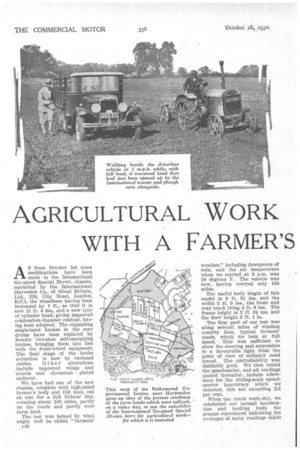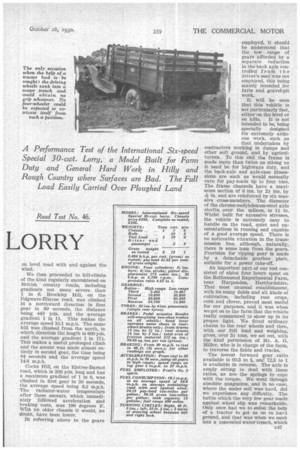AGRICULTURAL WORK WITH A FARMER'S LORRY
Page 104

Page 105

Page 106

If you've noticed an error in this article please click here to report it so we can fix it.
Road Test No. 46.
AS from October 1st some modifications have been made in the International Six-speed Special 30-cwt. chassis, marketed by the International Harvester Co., of Great Britain, Ltd., 259, City Road, London, E.C.1, the wheelbase having been increased by 1 ft., so that it is now 11 ft. 4 ins., and a new type of cylinder head, giving improved combustion-chamber contour, having been adopted. The expanding single-band brakes in the rear drums have been replaced by Bendix two-shoe self-energizing brakes, bringing them into line with the front-wheel equipment. The final stage of the brake actuation is now by enclosed cables. Other alterations include improved wings and -scuttle and chromium plated radiator.
We have had one of the new chassis, complete with high-sided farmer's body and full load, out on test for a full 10-hour day, covering about 100 miles, partly on the roads and partly over farm land.
• The test was helped by what might well be called "farmers' c46 weather," including downpours of rain, and the air temperature when we started ,at 8 a.m. was 58 degrees F. The vehicle was new, having covered only 100 miles.
The useful body length of this model is 9 ft. 3? ins, and the width 5 ft. 9 ins., the front and rear track being 4 ft. 8 ins. The frame height is 2 ft. 01 ins, and the floor height 3 ft. 1 in.
The first part of our test was along several miles of winding country lane, typical farmers' roads, which we took at full speed. This was sufficient to show the steering and suspension in a favourable light from the paint of view of ordinary road travel. The controllability was distinctly good. We then tested the speedometer, and all readings quoted hereafter _.include allowance for the sliding-scale speedometer inaccuracy which we detected, this not exceeding 2.2 per cent.
'When the roads were, dry, we conducted our normal acceleration and braking tests, the graphs reproduced indicating the averages of many readings taken
on level road with and against the wind.
We then proceeded to hill-climbs of the kind regularly encountered on British country roads, including gradients not more severe than 1 in 6. Brockley Hill, on the Edgware-Histree road, was climbed in a northward direction in first gear in 89 seconds, the distance being 440 yds. and the average gradient 1 in 11. This makes the average speed 10.1 m.p.h. The same hill was climbed from the north, in which direction the length is 600 yds. and the average gradient 1 in 17i. This makes a useful prolonged climb and the ascent was made almost entirely in second gear, the time being 84 seconds and the average speed 14.6 m.p.h.
Cocks Hill, on the Elstree-Barnet road, which is 200 yds. long and has a maximum gradient of 1 in 6, was climbed in first gear in 50 seconds, the average speed being 8.2 m.p.h. The radiator-water temperature after these ascents, which immediately followed acceleration and braking tests, was 196 degrees F. With an older chassis it would, no doubt, have been lower.
In referring above to the gears employed, it should be understood that the low:range of gears afforded by a separate reduction in the back axle controlled froth the driver's seat was not employed, this being mainly intended for farm and gravel-pit work.
It will be seen that this vehicle is not particularly fast, either on the level or
on hills. It is not intended to be, being specially designed. for extremely arduous work, such as that undertaken by contractors working in dumps and other soft ground, and by agriculturists. To this end the frame is made more than twice as strong as it need be for highways duty, and the back-axle and axle-case dimensions are such as would normally care for pay-loads up to four tOns. The frame channels have a maximum section of 6 ins. by 2i ins, by la, in. and are reinforced by six massive cross-members. The diameter of the chrome-molybdenum-steel axle shafts, over the splines, is 1i in. Whilst built for excessive stresses, the vehicle is extremely easy tohandle on the road, quiet and unostentatious in running and capable of a good average speed. There is no noticeable vibration in the transmission line, although, naturally, there is some hum from the gears. Provision for tipping gear is made by a detachable gearbox plate, suitable for a power take-off.
An important part of our test consisted of abOut four hours spent on the Rothamsted Experimental Farm, near Harpenden, Hertfordshire. That most unusual establishment, with its many fields and all kinds of cultivation, including root crops, corn and clover, proved most useful for our purposes, and it was when we got on to the farm that the vehicle really commenced to show up in its proper light. We fitted ordinary chains to the rear wheels and then, with our full load and weighing, gross, over 3i tons, we set out, with the kind permission of Mr. A. G. Miller, who is in charge of the farm, to traverse the fields and tracks.
The lowest forward gear _ratio available is 60.3 to 1, and 72.3 to 1 is available in reverse. The axle is amply strong to deal with these ratios, as are the springs to cope with the torque. We went through absolute quagmires, and in no case, where the under soil was hard, did we experience any difficulty. The battle which the very low gear made against wheel slip was remarkable. Only once had we to enlist the help of a tractor to get us on to hard ground, and that was when we sank into a concealed water trench, which quickly buried the off-side driving wheel deeper than the hub, so that the "differential case was embedded. In such circumstances no fourwheeler could pull itself out.
At the time an International 10-20 h.p. tractor was opening up one of the fields, employing a twofurrow plough and pulverizer, and working to a depth of 6 ins, with a
furrow width of 14 ins. Rain was falling on the newly opened ground, yet we were able to drive at will over it and, utilizing the low backaxle reduction, we could even get along in the second gearbox drive, with which the ratio is 30.9 to 1. With the lowest ratio available it was possible to set the hand throttle and then to dismount from the vehicle, walking beside it as it ploughed its way at 2 m.p.h., or even slower, through the loose earth.
We were unable, to find a freak hillock providing exceptional gradients, but the International company tells us that this standard vehicle, with full load, has climbed the Tank Corps test hills at Farnborough, including the 1-in-2i portion.
For this class of work a partieulady stout clutch is necessary. In the case of the Six-speed Special the dry, single-plate clutch has six springs, which give a total engagement pressure of 1,080 lb. per sq. in., the disc diameter being 9 ins. This clutch works quite smoothly.
The springing stood up te the cross-country tests extremely well, the long approach road to Rotham c48 sted Farm and the field side tracks providing just the kind of test we required. The rear springs are 3 ft. 9 ins, long and 2i ins, wide, and, as well as recoil snubbers, they have the support of quarter-elliptic auxiliary springs fixed to the frame, which, with the full pay-load, just make contact when the vehicle is stationary. The front springs are 3 ft. 4 ins, long and 2 ins. wide ; these also have snubbing plates. All springs are shackled at rear.
Fuel-consumption tests on farm ground being impracticable, we confined ourselves to tests on normal country roads. Our.readings varied between 12.8 m.p.g. an 19.2 m.p.g, of fuel, the work figure resulting from severe conditions in the form of hills and a powerful head wind (in which circumstances we averaged 18 m.p.h.), and the best reading being obtained on a level arterial road partly with and partly against a wind of similar force (our speed averaging 29 m.p.h.). For ordinary long-distance operation, therefore, about 18 m.p.g. might be expected. Throughout our day's work the setting of the Zenith model 94BU car
buretter was : venturi, 19; main jet,
17; cap jet, 16; idling jet, 9. • The side-valve engine behaved well, not forgetting the low-gear work on the farm. It has three crankshaft bearings of 2 ins. diameter and n in., 2i ins. and 2i ins. length. The big-ends are 2 ins, in diameter and 1i, in. long. The compression ratio is not high, being 4:43 to 1. We are unable to give a
diagram of the valve timing.
The results of our test speak for themselves, and we need add only that the International has a good, long-standing reputation for, reliability, sound design and construction.




















































































































































































